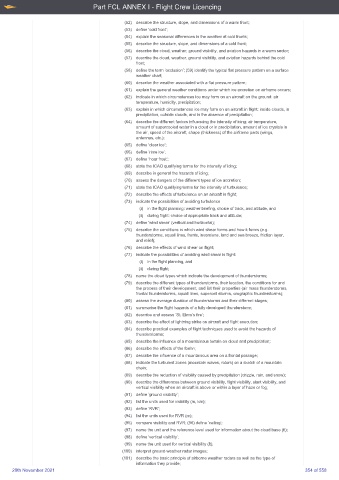Page 354 - UK Aircrew Regulations (Consolidated) 201121
P. 354
Part FCL ANNEX I - Flight Crew Licencing
(52) describe the structure, slope, and dimensions of a warm front;
(53) define ‘cold front’;
(54) explain the seasonal differences in the weather at cold fronts;
(55) describe the structure, slope, and dimensions of a cold front;
(56) describe the cloud, weather, ground visibility, and aviation hazards in a warm sector;
(57) describe the cloud, weather, ground visibility, and aviation hazards behind the cold
front;
(58) define the term ‘occlusion’; (59) identify the typical flat pressure pattern on a surface
weather chart;
(60) describe the weather associated with a flat pressure pattern;
(61) explain the general weather conditions under which ice accretion on airframe occurs;
(62) indicate in which circumstances ice may form on an aircraft on the ground: air
temperature, humidity, precipitation;
(63) explain in which circumstances ice may form on an aircraft in flight: inside clouds, in
precipitation, outside clouds, and in the absence of precipitation;
(64) describe the different factors influencing the intensity of icing: air temperature,
amount of supercooled water in a cloud or in precipitation, amount of ice crystals in
the air, speed of the aircraft, shape (thickness) of the airframe parts (wings,
antennas, etc.);
(65) define ‘clear ice’;
(66) define ‘rime ice’;
(67) define ‘hoar frost’;
(68) state the ICAO qualifying terms for the intensity of icing;
(69) describe in general the hazards of icing;
(70) assess the dangers of the different types of ice accretion;
(71) state the ICAO qualifying terms for the intensity of turbulence;
(72) describe the effects of turbulence on an aircraft in flight;
(73) indicate the possibilities of avoiding turbulence
(i) in the flight planning: weather briefing, choice of track, and altitude, and
(ii) during flight: choice of appropriate track and altitude;
(74) define ‘wind shear’ (vertical and horizontal);
(75) describe the conditions in which wind shear forms and how it forms (e.g.
thunderstorms, squall lines, fronts, inversions, land and sea breeze, friction layer,
and relief);
(76) describe the effects of wind shear on flight;
(77) indicate the possibilities of avoiding wind shear in flight:
(i) in the flight planning, and
(ii) during flight;
(78) name the cloud types which indicate the development of thunderstorms;
(79) describe the different types of thunderstorms, their location, the conditions for and
the process of their development, and list their properties (air mass thunderstorms,
frontal thunderstorms, squall lines, supercell storms, orographic thunderstorms);
(80) assess the average duration of thunderstorms and their different stages;
(81) summarise the flight hazards of a fully developed thunderstorm;
(82) describe and assess ‘St. Elmo’s fire’;
(83) describe the effect of lightning strike on aircraft and flight execution;
(84) describe practical examples of flight techniques used to avoid the hazards of
thunderstorms;
(85) describe the influence of a mountainous terrain on cloud and precipitation;
(86) describe the effects of the foehn;
(87) describe the influence of a mountainous area on a frontal passage;
(88) indicate the turbulent zones (mountain waves, rotors) on a sketch of a mountain
chain;
(89) describe the reduction of visibility caused by precipitation (drizzle, rain, and snow);
(90) describe the differences between ground visibility, flight visibility, slant visibility, and
vertical visibility when an aircraft is above or within a layer of haze or fog;
(91) define ‘ground visibility’;
(92) list the units used for visibility (m, km);
(93) define ‘RVR’;
(94) list the units used for RVR (m);
(95) compare visibility and RVR; (96) define ‘ceiling’;
(97) name the unit and the reference level used for information about the cloud base (ft);
(98) define ‘vertical visibility’;
(99) name the unit used for vertical visibility (ft);
(100) interpret ground-weather radar images;
(101) describe the basic principle of airborne weather radars as well as the type of
information they provide;
20th November 2021 354 of 558

